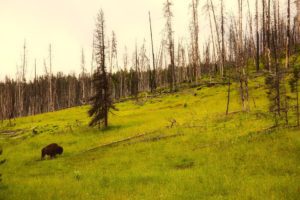I visited Yellowstone National Park in the Spring of 1989 following wildfires that burned over 793,880 acres of forest in 1988. I was amazed by the amount of regrowth that had already occurred more proof that Nature is designed to regenerate.
There are certain trees and bushes with seeds that only open under intense heat, allowing the seedlings to begin restoring the ecosystem after a catastrophic event like wildfire. For example, in Yellowstone that year there were millions and millions of new aspen seedlings that had sprouted in the ash. Trees can resprout using their extensive root systems. Some pine trees have cones that are glued shut with a strong resin that needs heat from a fire to allow the cones and seeds to open up. This helps them to become a part of the restoration of the ecosystem.
The Thomas wildfire and a mudslide occurred in Ventura County, California in 2017. It was followed by another fire a year later and then a mass shooting. I visited that area in 2019 and witnessed how much regrowth had occurred. I also observed firsthand the way the community came together to restore its ecological and social fabric. So, as human beings and as living systems, we too carry this ability to regenerate and restore ourselves and our teams.
What can we learn about restoring ourselves from nature?
Today we are coming out of a pandemic that has disrupted many of our notions of what is predictable in our lives, organizations and economies. I am noticing a pattern with senior leadership teams. Teams that were rock solid during the pandemic are starting to fray around the edges. The team that went into the pandemic isn’t the same coming out of it. For example, some people have left without celebrating their future and recognizing the loss to the team. Or, some new members have been hired, but haven’t been able to develop deep trusting relationships through virtual environments. There are exhausted team members who have a hard time leading teams that are showing signs of burnout.
This got me wondering how nature, a regenerative system, restores itself after a catastrophic event like a wildfire, flood, or earthquake. And if there were any examples that we could use to create conditions for the restoring healing needed in our teams and organizations. Ecologist Jiang Gaoming (2008) wrote about Letting nature heal itself sharing how the ecosystems recovered from the May 12th earthquake in Wenchuan. He says that “as long as there are seeds, roots, and soil, an ecosystem can quickly restore itself.” What are our organizational seeds, roots, and soil?
Seeds, Roots, and Soil
Based on Nature’s design, here are three practices that can help us recover as individuals and teams from the disruption of the last 2.5 years.
- Strengthen your center of gravity: in Aikido there is a practice of standing with your knees slightly bent and sinking into your center of gravity in the body. When we focus on our physical center, we become impossible to pick up or be pushed over. Nature’s center is to regenerate life. Our individual purpose and the organization’s highest shared purpose is a form of centering. This helps us stay focused on what we are trying to move toward, and it provides us with a sense of meaning that arises from our “roots” – from inside us. This helps us to hold amidst the craziness around us.
- Look for what we want to carry forward into the future: There are always things from our past that stand the test of time (ways of thinking, practicing, and being) that we don’t want to lose during disruption. Naming the deep wisdom or important values we want to hold sacred going forward acts like seeds that open up under intense heat or challenge.
- Have faith in yourself and your natural resilience: This is the soil in which you grow and gain the nutrients to maintain your balance. When things are highly chaotic, we can lose sight of our inner resilience. Take some time to remember all the disruptions you have lived through and made it to the other side. These experiences are affirmations of our natural ability to learn, adapt, and emerge from challenges. It is these memories that help us remember that we have and will continue to restore ourselves even if today it seems very challenging.







Have faith in ourselves and our natural resilance.